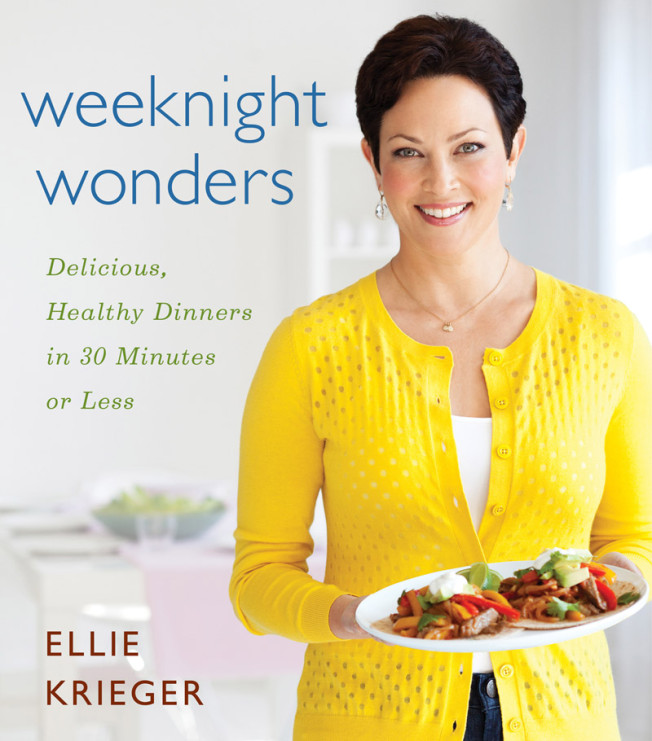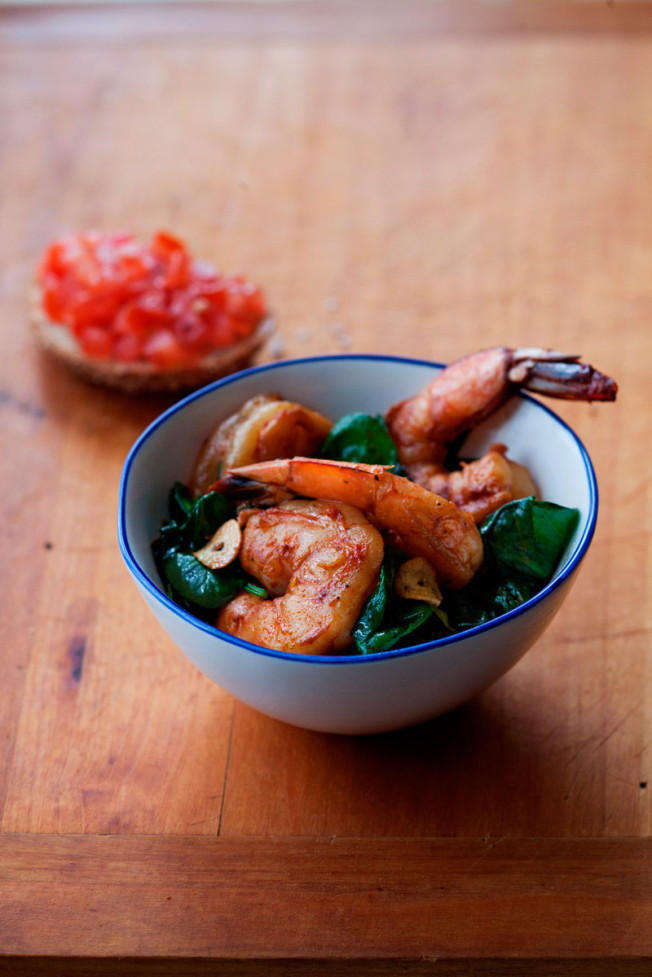We all want to eat healthy, delicious meals every night, especially in the wake of an indulgent holiday season. But after a long day — when we’re running low on time and creativity — it can be especially challenging to get a homemade meal on the table. Enter Weeknight Wonders, a new cookbook from author and Food Network star Ellie Krieger, full of 150 solutions for nutritious dinners on busy weeknights.
From soups and sandwiches to one-pot meals, each of Ellie’s recipes was designed to take no longer than 30 minutes, from the time you start prepping to the minute the plates hit the table. And though the recipes keep calories, fat and sodium in a healthy range, we can promise they don’t sound like diet food (think Chicken Enchiladas with Avocado Sauce or Chipotle Beef-Stuffed Portobello Mushrooms). As a bonus, the book also includes tips on stocking your pantry; cooking grains, veggies and meats; and some of her favorite healthy shortcuts.
Here, we talk to Ellie all about Weeknight Wonders, her healthy eating philosophy, and her go-to ingredients and meals. Read on, then join us in stores for a book signing and cooking demonstration with Ellie!
 Why would you encourage people to cook at home more often during the week? What are some of the benefits?
Why would you encourage people to cook at home more often during the week? What are some of the benefits?
The benefits of cooking at home are remarkable! When you cook at home you automatically eat healthier ( more nutrients and less sodium and saturated fat), and you eat fewer calories than you would if you got take-out or ate restaurant food. The very act of cooking can help you feel more satisfied with your meal. And it costs less. So, over time, cooking at home could keep you healthier, slimmer and save you money. Plus, you get to have the food exactly as you and your family like it. Sounds like a pretty good deal, don’t you think!?
Tell us about your Usually-Sometimes-Rarely philosophy. How does it influence your shopping and cooking?
Most importantly, notice there is no such think as a “Never” food to me. If I am told I can’t have a food, I suddenly want it about 1000% more. Besides, saying Never to a food is unnecessarily restrictive (unless you have a medical reason, or course). Rather, I categorize foods as “Usually”, Sometimes” and “Rarely.” If you make the “Usually” foods the backbone of what you eat (vegetables, fruit, lean proteins, whole grains, beans, nuts, seeds, low-fat daily and healthy oils) you can sprinkle in “Sometimes” foods like white flour or dark chocolate and even “Rarely” foods like butter and bacon, for flavor and variety.
I developed this balanced way of looking at foods back when I was doing nutrition counseling, and it was incredibly effective for helping people in the long term. Since then, it has been the basis of every recipe I have developed and also the way I personally eat. I find it is an ideal way to have both health and taste in a really live-able way.
How do you strike balance with your eating? Any tips for others wanting to eat the foods they love while still being healthy?
Literally following the Usually-Sometimes-Rarely way of eating — and all it takes is cooking my recipes to do that — means you will achieve balance and be allowed to eat the foods you love and be healthy. Another cornerstone philosophy of mine to enjoy food in a healthful way is to practice eating mindfully. Rather than gulping down your food, take your time to really savor each bite. When you do that, you will enjoy your food more and likely wind up eating less.
How do you mix things up so you don’t get into boring routines?
It is easy to get stuck in a rut with weeknight cooking, always buying the same ingredients and making the same dinners. That is one of the reasons I wrote Weeknight Wonders: There are 150 exciting ideas in there that you can have on the table in literally 30 minutes or less. To bust boredom without changing everything at once, choose 1 or 2 new recipes to try out each week. Before you know it, you will have a fresh new repertoire and still have lots more to choose from.
What does a typical week of dinners look like for you?
It depends on the season. Right now I am really into making soups and chili. I like to make double so I have two night’s worth of dinners on hand. I pretty much always have a pot of something good in the fridge throughout the winter! (I love the Rush Hour Chili in the book as well as the Meatballs and Simple Marinara and the Savory Carrot and Cashew Soup.) On top of that, I typically will whip up one or two skillet dinners a week, like the Pork Tenderloin with Grapes and Fennel and the Provencal Chicken and White Bean Stew.
What are some of your favorite go-to healthy ingredients for stocking your pantry?
There is a full pantry list in the book, but some of my must haves are canned beans and tomatoes (no salt added); a variety of quick-cooking whole grains like whole-grain pasta, bulgur, and quinoa; a variety of flavorful vinegars; and good olive oil.
Are there any new or unfamiliar ingredients you’d recommend people try?
I have been kind of obsessed with smoked paprika lately. It adds so much depth and flavor and gives the simplest foods a huge wow factor. I add it to eggs and potatoes and use it in a rub for poultry. I have a recipe in the book for Shrimp with Spinach, Garlic and Smoked Paprika that is insanely simple and insanely delicious.
What techniques or ingredients do you find to be especially suited for busy weeknights?
I love to do dishes where you get your protein, vegetable and sauce all in one skillet. I have so many of those in the book, from Moroccan-Style Chicken with Lemon, Fennel and Olives to Pork Tenderloin with Sweet-and Sour Red Cabbage and Dried Cherries to Cod with Miso Ginger Broth.
Any tips for making traditional recipes lighter or more nutritious? Easy substitutions?
Swap sour cream or up to half the mayo in a typical dish with Greek yogurt, use whole grain breads and pasta instead of refined. Use olive oil or canola oil instead of butter wherever it makes sense, and always find a way to incorporate more vegetables into a dish.
What are some of your favorite fruits and vegetables to cook with and why?
One of my favorite thing about fruits and vegetables is the incredible variety you can get, so I love to experiment with all different kinds. But on busy weeknights I like to take advantage of those that require little or no prep like prewashed greens, snow peas, tomatoes, grapes, and dried fruits.
What’s for dinner tonight?
Tonight I am making a Chicory Salad with Blue Cheese and Cranberries and my Savory Carrot Cashew Soup. Perfect winter dinner!
Please share a recipe from the book and tell us why you love it.
This dish — Shrimp with Spinach, Garlic, and Smoked Paprika — has big flavor and a luxurious appeal, even though it has just a few simple ingredients and takes less than 15 minutes to get on the table. Plus, you get your vegetable and protein in one pan. It is a perfect example of a Weeknight Wonder!
Shrimp with Spinach, Garlic, and Smoked Paprika
If you have yet to discover the glory of smoked paprika, this is your official invitation. Made from smoked red peppers, it is a key ingredient in Spanish cooking (where it is called pimentón). It imparts a deep ruby color and distinctive smoky flavor and aroma, instantly giving the simplest foods, like eggs, potatoes, or grilled chicken, a huge wow factor. In this dish, it teams up with golden toasted garlic for doubly exciting seasoning for sautéed shrimp and spinach. You can buy smoked paprika in sweet or hot varieties, but I buy the sweet because I figure you can always add some heat if you want it—and I do add a touch here.
1 1⁄4 pounds large shrimp (about 20 per pound), peeled and deveined, tails on
3 large cloves garlic
5 cups lightly packed baby spinach leaves (5 ounces)
3 tablespoons olive oil
2 teaspoons smoked paprika
1⁄4 teaspoon salt
Pinch cayenne pepper
Rinse the shrimp and pat dry with a paper towel. Thinly slice the garlic. Coarsely chop the spinach.
Place the oil in a large nonstick skillet and heat over medium-high heat. Lower the heat to medium-low, add the garlic, and cook, stirring frequently, until the garlic is golden, about 5 minutes. Watch closely so the garlic does not burn. Transfer the garlic to a small dish using a slotted spoon, leaving the oil in the skillet.
Raise the heat to medium-high, add the shrimp, paprika, salt, and cayenne to the skillet, and cook until the shrimp turns pink and is nearly cooked through, about 3 minutes. Stir in the spinach, return the garlic to the pan, and cook until the shrimp is opaque throughout and the spinach is wilted, 1 to 2 minutes more.
SERVING SIZE 1 1⁄4 cups (6 or 7 shrimp)
CALORIES 260; Total Fat 13g (Sat Fat 2g, Mono Fat 7.8g, Poly Fat 2.1g); Protein 30g; Carb 6g; Fiber 2g; Cholesterol 215mg; Sodium 410mg
EXCELLENT SOURCE OF Iron, Phosphorus, Protein, Selenium, Vitamin A, Vitamin B12
GOOD SOURCE OF Calcium, Copper, Magnesium, Niacin, Vitamin B6, Vitamin C, Zinc
Book Signings & Cooking Demonstrations with Ellie Krieger
Join us for a special book signing with Ellie Krieger. She will be signing copies of her new cookbook, Weeknight Wonders: Delicious, Healthy Dinners in 30 Minutes or Less. Please note: Ellie will only be personalizing copies of Weeknight Wonders purchased at Williams-Sonoma. Proof of purchase required.
Mall At Short Hills
Sunday, January 12, 2014 at 1:00pm
1200 Morris Turnpike, Short Hills, NJ 07078
(973) 467-3641
Santa Monica
Saturday, January 18, 2014 at 1:00pm
1600 Montana Ave., Santa Monica, CA 90403
(310) 586-1018


